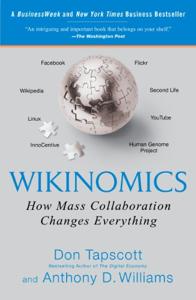
Want to learn the ideas in Wikinomics better than ever? Read the world’s #1 book summary of Wikinomics by Don Tapscott, Anthony D. Williams here.
Read a brief 1-Page Summary or watch video summaries curated by our expert team. Note: this book guide is not affiliated with or endorsed by the publisher or author, and we always encourage you to purchase and read the full book.
Video Summaries of Wikinomics
We’ve scoured the Internet for the very best videos on Wikinomics, from high-quality videos summaries to interviews or commentary by Don Tapscott, Anthony D. Williams.
1-Page Summary of Wikinomics
Overview
Throughout history, people have tried to get ahead by protecting their ideas and secrets. They thought that any successful entity would need to protect its data, research, and secrets in order to stay one step ahead of everyone else.
However, the trend in today’s economy is to give away information and resources. In fact, it’s more effective than keeping everything to yourself. The stories below explain why mass collaboration is so useful and what you can learn from them.
The Advent of Wikinomics
In 1999, Goldcorp was struggling to survive. The company’s debt and production costs had grown, and the gold market had become stagnant. To make matters worse, the mine in Red Lake wasn’t producing as much ore as it used to. With a shrinking marketplace and lack of incoming resources, Goldcorp appeared doomed to fail.
Goldcorp’s CEO Rob McEwen was upset. He gave his geologists more funding to find new gold caches near the Red Lake site, but he knew that it was a long shot. Some of the board members were getting concerned because they thought he was wasting money on an exploratory project that might not produce any results.
During a time of crisis, McEwen went to an MIT conference for professional development. He heard the story of Linux, which is a computer operating system that was created in 1991 by Linus Torvalds. In order to perfect his new operating system, Torvalds posted his code online and invited other programmers to edit it and make it better. Then he decided to make the new operating system available for free as long as people agreed to freely publicize any changes they made. Today Linux software is used all over the world because of its power to employ thousands of volunteer programmers’ wisdom. McEwen was blown away by this idea; could something similar work in gold?
In the mining industry, there is a lot of controversy over whether to share information about where one finds gold. If Goldcorp shares its data with other companies, won’t they use it to compete? McEwen knew this was a risk but decided that his company would follow in the steps of Linux and put all their data online for anyone to access. Anyone who could come up with an idea for finding more gold at Red Lake would win thousands in reward money.
Goldcorp, a mining company, decided to let the public help find gold. The website attracted geologists and others who were interested in finding gold. It was successful because hundreds of people contributed their ideas on where to look for gold and how best to mine it. Many of these contributors had experience that Goldcorp did not have, so they ended up discovering new places with significant amounts of gold.
A company that was on the brink of failure completely transformed itself by using an open source approach to problem-solving. This strategy reversed the company’s fortunes, and in just seven years it became a nine billion dollar operation.
While mass collaboration isn’t new (it’s been around in the open-source movement since the 1980s), it is a strategy that can help small and mid-sized companies better compete against larger ones. This happens because big brand names are often seen as authoritative, while startups don’t have as much leeway to take critical risks. Open sourcing one’s ideas gives them more credibility and allows organizations like Goldcorp to become leaders in their fields.
How Mass Collaboration Works
Throughout history, there have always been hierarchies in the business world. The CEO and board of directors rule over their employees, corporations influence communities, and producers dictate their demands to suppliers. These hierarchies have held power over consumers.






